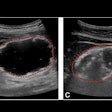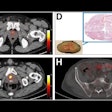Best Radiology Image
Minnies 2025 Winner: Twenty-minute F-18 florbetaben PET/CT scans acquired in a Siemens Biograph mCT scanner identify people at early risk for cognitive decline. Image from Guilherme Kolinger, MD, of Life Molecular Imaging in Germany, et al.
Amyloid PET scans are a significant tool for diagnosing Alzheimer’s disease, based on their ability to detect even small amounts of beta-amyloid deposits in the brain. Moreover, the U.S. Centers for Medicare and Medicaid has approved reimbursement for the scans in identifying patients who may be eligible for treatment with new drugs that have recently reached the market.
Fittingly, then, this year’s Best Radiology Image comes from a study reporting that amyloid PET scans in individuals with early signs of Alzheimer’s disease can identify those at higher risk of cognitive decline. The study was conducted by scientists at Lantheus subsidiary Life Molecular Imaging.
“This image demonstrates how quantitative analysis can reveal additional insights beyond standard visual assessment in amyloid PET imaging,” lead author Guilherme Kolinger, MD, told AuntMinnie. “The florbetaben PET scan was acquired following the routine clinical diagnostic procedure; no special protocol was required.”
 Volume with higher baseline signal for N1 accumulators and N1 non-accumulators of amyloid (red line) overlayed on the scan of an N1 accumulator (MNI space). Grey scale shows SUVR range. Blue line shows the Centiloid target region and the green line shows the reference region (whole cerebellum).European Journal of Nuclear Medicine and Molecular Imaging
Volume with higher baseline signal for N1 accumulators and N1 non-accumulators of amyloid (red line) overlayed on the scan of an N1 accumulator (MNI space). Grey scale shows SUVR range. Blue line shows the Centiloid target region and the green line shows the reference region (whole cerebellum).European Journal of Nuclear Medicine and Molecular Imaging
To identify the region highlighted in red, an amyloid-negative population (at baseline) with subjective cognitive decline was assessed with a voxel-based analysis using standardized uptake value ratios (SUVRs). Then, the baseline SUVR images of amyloid accumulators versus nonaccumulators were compared. Amyloid accumulation status was defined using the Centiloid method and with a five-year follow-up, Kolinger said.
The results showed that accumulators exhibited higher baseline SUVR in the red-marked region, which corresponds to part of the precuneus, a brain area known to play a role in early Alzheimer's disease. This region overlaps with the Centiloid target region (shown in blue), underscoring the potential of this approach to enhance preclinical Alzheimer's disease assessment, Kolinger added.
“What sets it apart is the application of quantitative analysis, which provides deeper insight beyond visual interpretation alone. Subtle changes that may be difficult to discern visually were detected through quantification, enabling the identification of the area highlighted in red,” Kolinger said.
Ultimately, Kolinger noted that quantitative image analysis using the Centiloid method, as an adjunct to visual assessment, is not yet fully integrated into routine clinical practice. The subregion identified in the study is not currently included in standard software outputs, but could become part of future clinical workflows pending further validation in larger cohorts and at the individual level, he added.
Runner-Up: First x-ray image taken in space. Image from Chun Wang, et al.
Scientific Paper of the Year
Minnies 2025 Winner: Private Equity Acquisitions of Radiology Practices from 2013 to 2023: National- and State-Level Analyses. Khunte, et al, American Journal of Roentgenology, March 5, 2025. To learn more about this paper, click here.
Over the past decade, private equity-funded acquisition of radiology practices in the U.S. has spiked, inciting significant controversy over its impact on the specialty. The winner selected for Scientific Paper of the Year by the Minnies expert panel took a deep dive into data and found that private equity firms acquired more than 150 radiology practices involving nearly 3,500 locations between 2013 and 2023.
The research was motivated by the rapid rise of private equity (PE) investment in healthcare in the U.S., in particular in physician practices, and a relative gap in rigorous data on how these trends affect radiology, co-authors Mihir Khunte and Yashaswini Singh, PhD, from Brown University in Providence, RI, told AuntMinnie.
“There are no systematic reporting or requirements for private equity investments in health care," Singh said. "As a result, to identify PE acquisitions in radiology, this study involved detailed hand-collected data and multiple datasets to identify the practice affiliation of radiologists nationally."
The research duo used multiple datasets (e.g., the PitchBook database, Medicare data, web searches) to identify and verify PE acquisitions of radiology practices, mapping ownership transitions, and quantifying how many radiologists are affiliated with PE-acquired practices across states.
The study found that compared with 2013, when 0.88% of all radiologists in the study were under private equity employment, 11.7% of all radiologists nationally in 2023 were private equity-employed. The latter includes 12% of all diagnostic radiologists and 6.7% of all interventional radiologists who were employed in this way.
The states with the highest percentage of radiologists being private equity-employed in December 2023 included Nevada (46.5%), Arizona (44.2%), Alaska (29.1%), Texas (26.9%), and Florida (23.9%). Radiology Partners (70.4%) made up the largest proportion of private equity-employed radiologists nationally, followed by LucidHealth (8.2%) and U.S. Radiology Specialists (6.7%).
Finally, in December 2023, private equity-acquired radiology practices were associated with 3,463 practice locations. That's 16% of 21,556 national practice locations, the researchers found.
Ultimately, radiology's fragmented practice landscape presents significant opportunities for consolidation, while its dependence on advanced, capital-intensive technology makes it well-positioned to benefit from external investment and coordinated management, Khunte and Singh suggested.
“These findings highlight how rapidly the practice landscape is evolving and raise important questions about how changes in practice ownership may affect radiologists, patients, and the broader healthcare system,” Khunte added.
Runner-up: Projected Lifetime Cancer Risks From Current Computed Tomography Imaging. Smith-Bindman, et al, JAMA Internal Medicine, April 14, 2025.
Best New Radiology Device
Minnies 2025 Winner: Magnetom Flow.Ace, Siemens Healthineers
The Magnetom Flow.Ace was 17 years in the making, which roughly aligns with the timing of the first worldwide helium shortages in 2006. The scanner is an ultrapremium, wide-bore, high-performance gradient MRI system and the company's first 1.5-tesla platform with a closed helium circuit and no quench pipe.
 The Magnetom Flow.Ace 1.5-tesla MRI scanner.Siemens Healthineers
The Magnetom Flow.Ace 1.5-tesla MRI scanner.Siemens Healthineers
“The lack of helium is what’s most exciting for us,” Katie Grant, PhD, head of Magnetic Resonance at Siemens Healthineers North America, told AuntMinnie.
Cleared for use in the U.S. in June, the Magnetom Flow.Ace requires just 0.7 liters of liquid helium for cooling, compared with conventional MRI scanners, which require more than 1,000 liters. This feature is due to the magnet’s DryCool technology, the company said.
The system design also eliminates the need for a quench pipe. In conventional scanners, this is needed to safely allow large amounts of gaseous helium to escape directly into the atmosphere during an emergency shutdown. The company also highlighted that the Magnetom Flow.Ace reduces annual energy consumption by more than 30%, owing to the system's Eco Power Mode.
The system has a 60 cm bore and is the first Siemens MRI scanner to be marketed to the veterinary radiology community as well as for general radiology, with coils now available for both fields. The scanner’s contour coils are flexible and adaptable to different human and animal anatomies.
The scanner is also equipped with AI to support automated workflows, as well as improved image quality and shorter exam times. The Magnetom Flow.Ace has a feature called myExam Companion that can guide users of different skill levels, from push-button scans for routine procedures to more advanced exams, the company said. The software supports more than 90% of body regions. Meanwhile, the scanner's Deep Resolve image reconstruction technology enables accelerated image acquisition, removes noise, and improves the sharpness of small structures.
“The Flow.Ace is a combination of all the best that’s come before it,” Grant said.
Runner-up: Signa Sprint, GE HealthCare
Best New Radiology Software
Minnies 2025 Winner: Viz 3D CTA AI software, Viz.ai
After two years in a row of awarding the Best New Radiology Software Minnies award to AI-based reporting applications, the Minnies Expert Panel elected to recognize a neurovascular imaging offering for the 2025 Minnies award.
Viz 3D CTA automatically converts CT angiography (CTA) scans into high-resolution AI-enhanced 3D images, offering physicians an intuitive and efficient method to assess vessel anatomy and pathology from anywhere, according to the firm.
“By making 3D imaging accessible and actionable, it helps teams make faster, more confident decisions in acute care scenarios -- particularly in stroke, where every minute counts, said Carolyn Jones, senior director for marketing communications and brand.
 Viz 3D CTA automatically converts CT angiography scans into high-resolution AI-enhanced 3D images.Viz.ai
Viz 3D CTA automatically converts CT angiography scans into high-resolution AI-enhanced 3D images.Viz.ai
Viz.ai said it developed the software to address neurovascular imaging challenges such as delays due to manual 3D renderings, limited spatial context in PACS, and difficulty viewing smaller or more distal vessel abnormalities. The software also features automated postprocessing, skull-stripped views, and interactive tools such as sagittal and axial rotation, the company said.
“We believe the strong response from the radiology community reflects the enthusiasm for tools that simplify complex workflows, enhance visualization, and ultimately improve outcomes for patients,” Jones told AuntMinnie. “This recognition is a testament to the close collaboration between our clinical partners and our product teams, who share a commitment to transforming how healthcare is delivered.”
This Minnies win is the second for Viz.ai. The firm received the 2018 Minnies award for Best New Radiology Software for Viz LVO.
Runner-up: Protect Her AI women’s health software platform, Covera Health
Best New Radiology Vendor
Minnies 2025 Winner: Rhapsody
A healthcare interoperability firm with more than 1,900 customers, Rhapsody made a splash in radiology earlier this year with the launch of Image Director, a software application designed to help organizations modernize imaging workflows and reduce infrastructure complexity.
“Radiology has always been a proving ground for healthcare innovation, and we see Image Director as a natural extension of our mission to make meaningful data available, connected, and useful across every care setting,” said Jitin Asnaani, chief product officer. “This [Minnies] recognition affirms the work the Rhapsody team has done to build infrastructure that helps radiology networks act faster, remove complexity, and prepare for the next era of AI-powered imaging.”
By managing DICOM, HL7, and FHIR data across cloud, edge, and hybrid environments, Image Director supports efficient routing of imaging data between modalities, PACS, vendor-neutral archives, AI models, and clinical systems, according to the vendor.
“Image Director represents a major milestone in Rhapsody’s strategy to expand from traditional message- and API-based integration into broader digital health enablement, giving imaging and radiology the same trusted, scalable infrastructure already powering clinical and operational systems across the care continuum,” Asnaani told AuntMinnie.
Runner-up: OncAI
Best Educational Mobile App
Minnies 2025 winner: CTisus iQuiz 25, Elliot Fishman, MD, (iOS)
Five years after it won its first Minnies award for Best Educational Mobile App, CTisus iQuiz 25 is back in the winner’s circle.
 The popular radiology quiz app is in the hunt for its second Minnie for Best Educational Mobile App.Elliot Fishman, MD.
The popular radiology quiz app is in the hunt for its second Minnie for Best Educational Mobile App.Elliot Fishman, MD.
Part of the extremely popular CTisus family of educational apps, the radiology quiz app features over 1,800 cases in 15 anatomical regions. Quiz cases feature audio discussions and imaging pearls.
Previously known as iQuiz, the app was renamed to highlight the many recent updates and upgrades to the app, said Elliot Fishman, MD, of Johns Hopkins University. For example, iQuiz 25 has been upgraded to a universal app for both iPhone and iPad. What’s more, over 300 new cases were added and the user interface was improved to deliver a smoother and more pleasant user experience, according to Fishman. The app is updated every six months.
“In an era where little is recognized and at times mediocrity seems to be in vogue, AuntMinnie every year helps us realize that excellence is important and what could be more important than the winner being selected by your peers,” Fishman said. “We have won 14 Minnies now and already are working hard to see if we can win our 15th next year.”

















